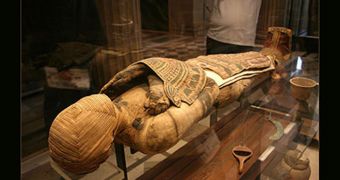Researchers at the British Museum discovered a spatula used for scooping out brains inside the skull of a 2,600-year-old mummy.
The grim discovery was made while Egyptologists were analyzing some mummified bodies as part of a larger project designed to unveil the mysteries of the mummification process. Researchers used CT scans to examine eight mummies that will be part of a new exhibition at the London museum, and one of them was revealed to have had a foreign object lodged inside its skull, Metro reports.
Using modern technology that produces 3D images, experts virtually unwrapped the mummies layer by layer and examined details that would give us clues about their lives and deaths. So far, they have made some unusual discoveries, such as tattoos, bad teeth, and now a spatula lodged in the skull of a man.
The striking image of the mummified body, which belongs to a man who died in Thebes, Egypt, around 600B, clearly shows the object in his head, as well as a series of dental abscesses which would have caused the man terrible pain, according to experts.
It is thought the wooden or reed tool broke when the embalmer was trying to break up the man’s brain so that he could scoop it out through the nostrils. Although now it seems a little gruesome, this was a normal step in the ancient practice of embalming and mummification. The embalmers usually removed the dead person's organs, including their intestines, stomach, liver and brain.
Recently, we have also learned about an unusual case where a 1,700-year-old Egyptian mummy was found without heart, though it is well known that this organ was the only one left in place during the mummification process because Egyptians believed that without the heart, a person would not have been able to move on to the afterlife.
The museum’s director Neil MacGregor said, “This new technology is truly ground-breaking. It allows us to reconstruct and understand the lives of these very different individuals.
“This is a project made possible through recent technological advances and I am delighted the museum is at the forefront of this research and presentation,” he added.
The British Museum’s Ancient Lives, New Discoveries exhibition will run from May 22 to November 30. It will also feature the remains of a female singer called Tamut, who lived in the same area in around 900 BC and was buried with amulets and jewels befitting her high status.

 14 DAY TRIAL //
14 DAY TRIAL //